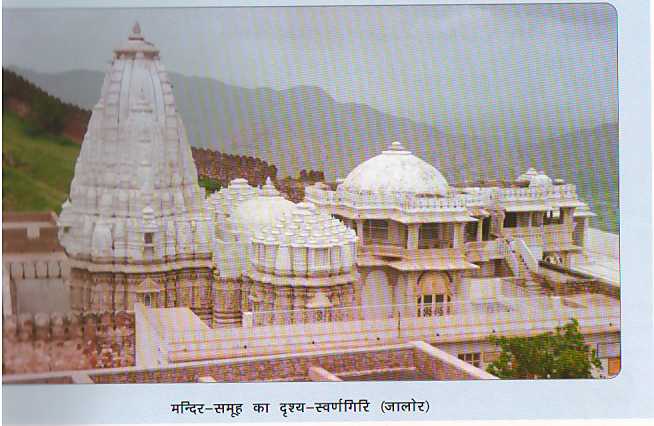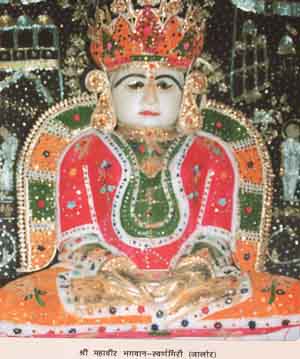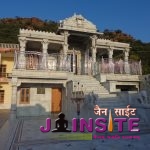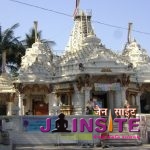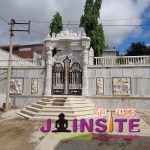SHRI SWARNAGRI TIRTH
PRESIDING DEITY AND LOCATION :
Sri Mahavir Bhagwan in white color, seated in a lotus posture, of height 100 Cms in a shrine in Jalore Fort on Swarnagiri hills near the city of Jalore. (Shve).
ANTIQUITY AND SALIENT FEATURES :
In the past Swarnagir was famous as Kanakachal. Once upon a time there lived here a large number of millionaire Jain householder families. A reference is available stating that during their rule the respective kings built here Jain temples such as “Yakshavasati”, “Ashtapad” etc. According to the reference, during the rule of King Sri Nahad successor of King Sri Vikramaditya, the temples would have been built between Vikram years 126 to 135 by King Nahad, The mention of these temple is made in a composition entltled “Vichar Shreni” by Sri Mahendrasurishvarji and in “Ashtottari” of Sri Mahendrrasurishvarji in 13th Vikram century. This place has been referred to as “Kanakachal” in “Saklaarhat Stotra” a laudatory composition. This temple of “Yakshavasati” is stated to have been repaired and renovated by Sri Kumarpal Raka in Vikram year 1221. In “Swarnagiri” the temple of Sri Parshvanath Bhagwan built by Sri Kumarpal Raja known as “Kumar Vihar” , it is stated, was ceremonially consecrated in Vikram year 1221 at the hands of Sri Vadidevsurishvarji.
Reference are available about the consecration of arches in the temple by Sri Puranchandrasuriji in Vikram year 1256, of fixing a gold-mast on the chief temple sikhar in VIrkam year 1265 and of fixing a gold “Kalash” on the main sikhar in Vikram year 1268 at the hands of Sri Ramchandrasuriji who composed seven “Dwatrishikha” inSanskrit language. There is a reference that during the period of Jehangir, son of Emperor Akbar, the chief minister Sri Jaimalji Munot of the local ruling king Sri Gajsinghji built in Swarnagiri one Jain temple and carried out renovations on all other temples in Vikram year 1681. It is stated that Srimati Sarupad and Sohag, wives of minister Sri Jaimalji also had consecrated and installed idols of which the most are even found today. It is stated that after renovations were carried out on this temple of Sri Mahavir Bhagwan by minster Sri Jaimalji, its ceremonial consecration was conducted at the hands of Sri Jaisagarganiji. This is believed to be the same “Yakshavasati” temple which was renovated earlier even by Sri Kumarpal Raja. The last renovations were done as a result of religious discourses by Sri Vijayrajendrasuriji.
At the foothills of Swarnagiri, it is stated that Jabalipur (Jalore) was founded during the 2nd Vikram year century. A reference is available about the completion of the volume entitled “ Kuvalaymala” by Acharya Sri Udyotansuriji in the temple of Sri Adinath Bhagwan in Jabalipur in Vikram year 835. There existed then in Jabalipur an extra large size temple called “Ashtapad” which is amply described in the inscriptions dated Vikram year 1296 of Lavanyasahi temple of Mt. Abu. There is a reference in which it is stated that in Vikram year 1293, Sri Yashovir minister of Sri Udaysinh Raja, built a marvelously crafted mandap in the temple of Sri Adinath Bhagwan. The minister was a king among donors besides being himself a master of structural science.
According to Khatargachha Survavali, during the reign of Raja Udaysinhji, on Saturday, Vaishakh Sukla 13 in Vikram year 1310 in “Swati” constellation, in the temple of Sri Mahavir Bhagwan, a great festival of joy and éclat was held in the presence of kings, other prominent persons and minister Sri Jaisinhji for the consecration ceremonies of the idols of 24 Tirthankars. During the occasion, Jain householder families from Palanpur and Vagadesh had also gathered in large numbers. There is a reference available about several Jain idols ceremonially consecrated and installed in the presence of Samantsinh in Vikram year 1342. Also a mention is found about an initiation and a garlanding ceremony having taken place in the presence of Sri Jinchandrasuriji on Jyest Krishna 10 in Vikram year 1371.
There after the ruler ALlahudeen Khilji’ s time many temples had pillaged and ruthlessly destroyed here. Today some samples of art are seen in the mosques. On some of these pieces of art work, even some Jain inscription can be found.
The uniqueness however is the fact from the 2nd Vikram century upto the 18th Vikram century, innumerable Jain kings, ministers and Shreshthis have performed here such deeds of great religious and social significance as would baffle description. In Vikram year 1292, minister Sri Yashovir of the local king Sri Udaysinh had participated in the consecration festival of Lavanyavasahi temple at Mount Abu erected by the sculpture artists of the time as per direction from Sri Vastupal, the chief minister of Abu. In that festival were present other 84 Kings, several ministers and prominent personalities. Yashovir himself being a master artist and a prolific craftsman had pointed out even in that marvelous temple 14 technical errors for which his proficiency was greatly appreciated. In Vikram year 1741 Sri Nensi, the son of the minister of this place named Munhot Jagmal as the Diwan of Jodhpur Maharaja Sri Jasavantsinhji. He had shown some extraordinary qualities of the Diwan as a result of which “Nensi ni Khyat” (story of Nensi) was composed which is still popular today.
On the hills which are 1200 feet above sea level and a plateau there upon which is 2 ½ Kms long and 1 ¼ Kms wide enveloped by a fort, the scene of these temples standing in majesty is indeed captivating and strikingly remindful of the past glory. Here, both in temples and mosques many ancient images and relics of artistic creations can be seen today.
Besides this temple, there are 4 more temples and one guru mandir within the fort on Swarnagiri hills and 12 more at the foot hills in Jalore. The Choumakh temple of Sri Parshvanath Bhagwan within the fort are believed to be ancient ones which are also known as Ashtapad Avatar mandir and Kumar Vihar Mandir respectively. In Sri Neminath Bhagwan’s temple at Jalore there is an idol of Guru Sri Hirvijaysuri-shvarji who gave religious discourses to Emperor Akbar, ceremonially installed in Vikram year 1656. The newly built Sri Nandishvar Dweep temple is also extremely attractive.
APPROACH – ROUTE :
From the temple in the fort on the hills to be base level, the distance is 2 ½ Kms from where Jalore Railway station is another 3 ½ Kms away where autos and taxis are available. To ascent the hills, chair carriers are available for aged pilgrims.
AMENITIES FOR JAIN PILGRIMS :
For lodging there are three dharamshalas, one on the hills and the other in Jalore near bus stand Kanchangiri Vihar dharamshala and another near Nandishvar Dvip temple with all facilities and a bhojanshala and Ayambilshala are also available.
MANAGED BY :
Sri Swarnagir Jain Shvetamber Teerth, (Jalore Durg)
P.O. Jalore – 343 – 001
Dist : Jalore, Rajasthan
Tel : 02973 – 32316 ( Durg Hills Office)
02973 – 32386 (Kanchangiri Vihar Off. )

